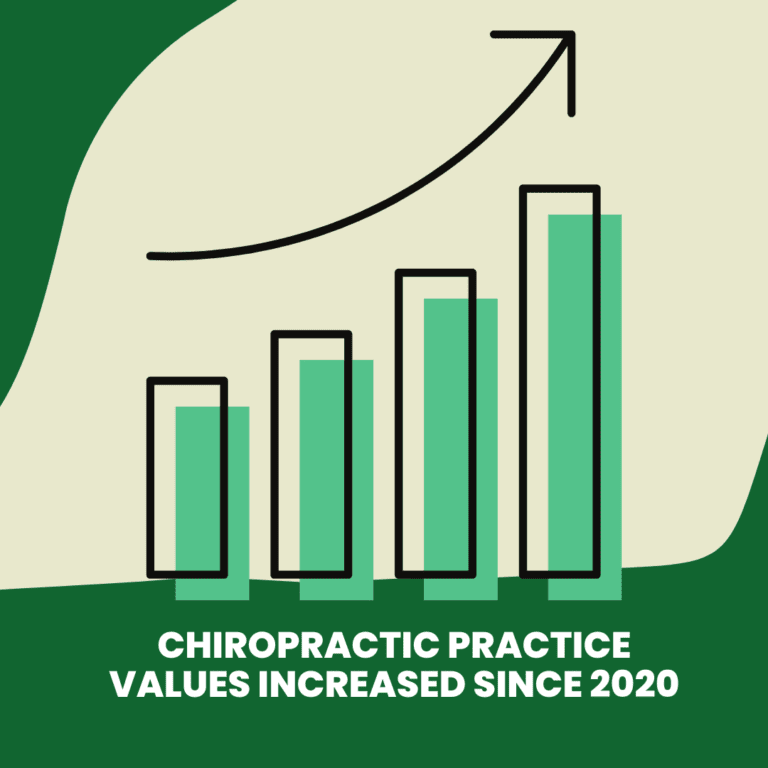So, why are people willing to invest in some Chiropractic clinics at a higher value now than years ago?
Published in Chiropractic Economics- January 2022
Chiropractic Clinic values have increased significantly over the past 24 months; why is this and is your clinic one of them?
Chiropractic Clinic Appraisals have been performed in many reasonable and unreasonable methods to determine valuation. It always comes back to: an asset is valued at what someone is willing to pay for it.

It starts with the alternatives. Presently, the bellwether US government ten-year note yields 1.29% per year. Yes, if you invest $1,000 the return on Investment (ROI) would be a meager $12.90 per year or $129.00 over ten years. The investment community presently has lots of cash but cannot find good returns with bonds or notes. These groups are now competing for alternative investment opportunities.
Investors are now looking at the Chiropractic profession as the next healthcare roll up investment. A roll up strategy is the process of acquiring and merging multiple smaller companies in the same industry and consolidating them into a large company. This is nothing new; financiers have been reaping healthy returns by investing in clusters of hospitals, orthopedic, dermatology, pediatric, dental, and almost all other disciplines of healthcare. Chiropractic has just begun to replicate this business model.
The Joint, the largest national public franchise of Chiropractic clinics today has increased their stock price from $8 in March of 2020 to $108 in September of 2021 with a market capitalization of 1.4 billion. Investors have finally recognized that Chiropractic is profitable.
Chiropractors are confused as to what their practices are worth. Today, it is even more varied due to the influx of outside investors, state taxes and changes in insurance fee schedules.
The intent of this article is to inform Chiropractors of the realistic value of their clinic and why.
In general, investors and private equity firms will pay more for a well-run profitable practice when a non-owner “caregiver/Chiropractor” than by the owner, CEO/Chiropractor, performs the patient care. They look at limiting the risk of attrition and the ease of system implementation. The investor will implement standard operating procedures and create a McDonald’s management approach. By creating standardization, they drive income services and reduce costs by economy of scale, resulting in a high ROI. With a large resource of capital, speed of acquisition, systems implantation their goal of profitability is met.
Most clinics are the opposite, structured with a single Chiropractor and no other professionals to generate income. One can now see the limiting factors for growth when purchasing the sole provider Chiropractic clinic. The non-Chiropractor investor has little interest in this model due to growth limitations.
Most typical is the Buy/Sell Chiropractic transactions where a Chiropractor buys a selling Chiropractic clinic without changing the business plan. The goal would be to replace the Seller with a Buyer and continue the past clinic income with equal effort. Due to the limited growth potential these practice values are lower.
The commonly accepted equation in most business acquisitions (including Chiropractic Clinic acquisitions) is the income model with multipliers. A simplified definition of the income model is net income of the Chiropractic clinic multiplied by a number, the multiplier. The multiplier in itself is an equation of many variables including empirical data and intangible opinions.
For example, a typical caregiver Chiropractic clinic that collects $175,000 with expenses of $75,000 has a net income of $100,000. The multiplier multiplies the income, which, for a typical practice, ranges between 1.4 through 2.2. In this case if we determine the multiplier is 1.7, the value would be ($100,000 X 1.7) $170,000.
The investor implements the identical equation but uses a higher multiple for the reasons stated above. For example, a CEO/Chiropractic clinic with Associate providers and or other disciplines that collect $1,000,000 with expenses of $550,000 result in the owner CEO/Chiropractor with a net income of $450,000. This clinic has high interest from investors and will yield a larger multiple. Over the past twenty-four months, the multiple range has increased to 2.0-6 times earnings. The value in this example using a four times multiple is ($450,000 X 4.0) $1,800,000.
The talent of a Chiropractic appraiser is to be able to value all clinics, be it one of these two examples or a hybrid. One must have the experience to know what is imperative to predict the future by evaluating the past and placing a value on it. The appraisal must satisfy the Seller, Buyer and lender or there will be no transaction. In addition, the appraiser must be able to defend the value to all who question it: the buyer, buyer’s counsel, accountant or lender. At the end of the day, the appraiser is an educator to the value of a unique asset.
Given the examples above, the goal for all Chiropractors selling their practice is to prepare for the sale at least twenty-four months prior to listing. Structure your practice where you, the acting Chiropractor, do not actively wear all hats. Increase profitability with technology and systems, not by staff. Document everything with professionalism and accuracy when building a practice sales proforma.
Working with thousands of Chiropractors, and most of the major Chiropractic franchises and large investment groups, the value of clinics has never been so diverse in relationship to business strategy and geography. The small, sole practitioner, insurance dependent Chiropractor in an undesirable state like California is at a value disadvantage. Whereas a large multi-doctor, multi discipline cash practice in Florida is in demand and has high value.
Chiropractic practice evaluation is not an exact science. Values fluctuate as insurance fee schedules change with a stroke of a pen, as tax codes are voted and investor interest waivers. As a Chiropractor the best one can do is become knowledgeable of the environment, prepare for your exit and realize who is the purchaser.
ABOUT DAVID FOSTER D.C.
Dr. Foster has practiced Chiropractic for the past 30 years and has co-owned 12 practices. His undergraduate education includes a BS degree from Boston University with a major in finance and marketing Prior to attending Life Chiropractic College he was a securities broker. With his acquired knowledge and experience Dr. Foster has consulted the Chiropractic community for past twenty-two years in appraisals, Buy-Sell and Associate agreements and strategic negotiations in addition to a wide variety of legal, franchise issues, financial and strategic issues related to the business of Chiropractic.
